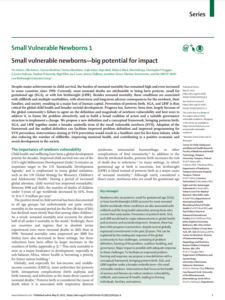
Despite major achievements in child survival, the burden of neonatal mortality has remained high and even increased in some countries since 1990. Currently, most neonatal deaths are attributable to being born preterm, small for gestational age (SGA), or with low birthweight (LBW). Besides neonatal mortality, these conditions are associated with stillbirth and multiple morbidities, with short-term and long-term adverse consequences for the newborn, their families, and society, resulting in a major loss of human capital. Prevention of preterm birth, SGA, and LBW is thus critical for global child health and broader societal development. Progress has, however, been slow, largely because of the global community’s failure to agree on the definition and magnitude of newborn vulnerability and best ways to address it, to frame the problem attractively, and to build a broad coalition of actors and a suitable governance structure to implement a change. We propose a new definition and a conceptual framework, bringing preterm birth, SGA, and LBW together under a broader umbrella term of the small vulnerable newborn (SVN). Adoption of the framework and the unified definition can facilitate improved problem definition and improved programming for SVN prevention. Interventions aiming at SVN prevention would result in a healthier start for live-born infants, while also reducing the number of stillbirths, improving maternal health, and contributing to a positive economic and social development in the society.